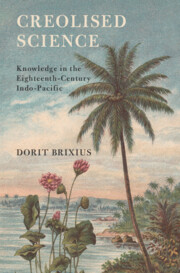Book contents
- Creolised Science
- Science in History
- Creolised Science
- Copyright page
- Dedication
- Contents
- Figures
- Acknowledgements
- Author’s Note
- Abbreviations
- Introduction
- 1 The Limits of French Colonial Visions and Science
- 2 The Acquisition of Knowledge and Plants, from Madagascar to China
- 3 Agriculture and Everyday Knowledge
- 4 Enslaved People as Knowledge Carriers
- 5 The Cross-Cultural Quest for Spices in South East Asia
- 6 Materials, Environment, and the Application of Knowledge
- Conclusion
- Bibliography
- Index
- Creolised Science
- Science in History
- Creolised Science
- Copyright page
- Dedication
- Contents
- Figures
- Acknowledgements
- Author’s Note
- Abbreviations
- Introduction
- 1 The Limits of French Colonial Visions and Science
- 2 The Acquisition of Knowledge and Plants, from Madagascar to China
- 3 Agriculture and Everyday Knowledge
- 4 Enslaved People as Knowledge Carriers
- 5 The Cross-Cultural Quest for Spices in South East Asia
- 6 Materials, Environment, and the Application of Knowledge
- Conclusion
- Bibliography
- Index
Summary
The introduction provides the key features and argument, divided into six sections. Besides a discussion of creolisation as a concept, the introduction lays out the central tenets of this monograph. This book is about the practices of plant knowledge; that is, the knowing how, but not the knowing that. By looking at the interconnections between people, materials, and nature, this book argues that creolisation took place in the social, cultural, epistemological, and material terms that determined the application of knowledge. As a creolising process, the knowledge of plants derived from cultures all over the world was integrated into the emerging practices within the island space. The cultivators included the Europeans who had migrated to Mauritius by choice, settlers born there, labourers, and enslaved people brought in by forced migration. Unsurprisingly, the agricultural knowledge of these individuals varied widely. Consequently, cultivation turned out to be a complex process of creolising the expertise that had originated in the local populations of the plants’ native habitats with the varying degrees of horticultural knowledge of the people living in Mauritius.
Keywords
- Type
- Chapter
- Information
- Creolised ScienceKnowledge in the Eighteenth-Century Indo-Pacific, pp. 1 - 17Publisher: Cambridge University PressPrint publication year: 2024



